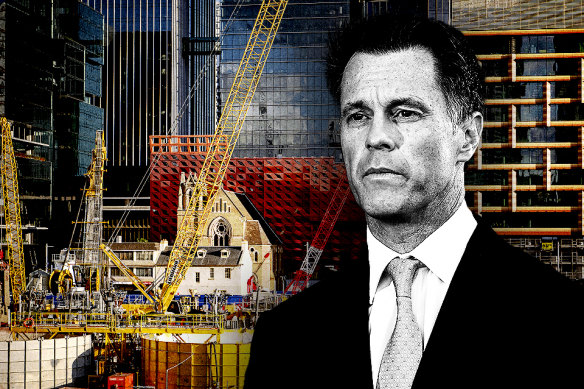- Exclusive
- Politics
- NSW
- Housing crisis
This was published 1 year ago
Planners listed 50 Sydney stations for high-density housing, then culled it
Planning officials in NSW listed more than 50 train and metro stations ripe for increased residential development, including Kogarah in Premier Chris Minns’ seat, but the register was culled in part because of uncertainty surrounding the $25 billion Metro West.
This week The Sydney Morning Herald revealed the Minns government is preparing to sign off on at least seven priority rezoning regions where it will dramatically ramp up residential density to meet ambitious housing targets set by national cabinet in August.

NSW Premier Chris Minns has pushed for Sydney to increase its density to solve the housing crunch.Credit: Images: Wolter Peeters; Kate Geraghty. Graphic: Aresna Villanueva
The proposal is yet to be signed off by cabinet, but includes Bankstown on the City and South-West Metro, and Crows Nest, Kellyville and Bella Vista on the North-West line.
But an original inventory compiled by the department was more substantial, containing suburbs on the existing heavy rail corridor as well as the proposed Metro West line where bureaucrats believed there was scope for residential uplift.
Industry sources who requested anonymity to discuss confidential briefings said the initial long list included stations along the North Shore heavy rail line, the East Hills line as far as Revesby and the inner west line between Central and Homebush.
The list also included stations on the Eastern Suburbs and Illawarra line towards Hurstville, which takes in Minns’ seat of Kogarah.
From more than 50 stations, officials culled the precincts down to about 15 mostly around existing Metro stations, by considering the rail line’s capacity, and issues such as schools, heritage and the area’s water and sewerage network.
That shortened list of 15 included stations on the Metro West line, including The Bays Precinct and Burwood North.
However, uncertainty surrounding the future of the Metro West line — and the Minns government’s need to find suburbs that can be developed quickly to meet national housing targets and address the city’s worsening affordability crisis — means those sites may not be part of the initial tranche of rezoning priorities.
Instead, seven precincts were chosen with up to 10 also under consideration before cabinet sign-off.
Amid speculation the government may be preparing to add stations to the Metro West line, multiple sources who spoke on the condition of anonymity said a significant density push along the proposed line would probably be part of a pipeline of development beyond the five-year accord if the $25 billion project went ahead.
There is no suggestion there was any political calculation in whether to include Kogarah on a short-list for priority development, but the existence of a much longer database indicates the Minns government may prepare a longer-term pipeline of locations to be primed for increased density.
While the final make-up remains a tightly held secret within government, the locations obtained by the Herald have raised eyebrows within the local government sector.
North Sydney Mayor Zoe Baker questioned why the government was considering increased density in Crows Nest when it has already been one of a series of priority rezoning precincts designated by the Coalition during its term in government.
“It’s like somebody forgot to brief the planning minister that we already are a priority precinct,” she said.
However, while the former government’s plan for Crows Nest and St Leonards earmarked about 6683 new dwellings to be built by 2036, senior sources within the former government said that during the creation of that plan senior ministers within the Coalition had pushed for greater uplift.
That precinct, which sits partly within the Willoughby electorate, held at the time by then-premier Gladys Berejiklian, was eventually scaled down after community concerns about overdevelopment.
Suburbs such as Cherrybrook in Sydney’s north-west were also among some of the initial targets for significant uplift by the former government, but were dropped before they were publicly released in part due to electoral considerations.
Chief executive of the developer lobby group Urban Taskforce Tom Forrest said while he welcomed the Minns government’s push for greater density, he hoped further priority precincts would be rolled out.
“We would be hoping that this is a first stage of transport-orientated development. We would hope and expect there will because there will need to be if the Minns government is going to meet its housing accord targets, or even get close to them,” he said.
Start the day with a summary of the day’s most important and interesting stories, analysis and insights. Sign up for our Morning Edition newsletter.